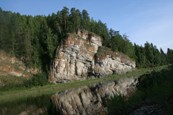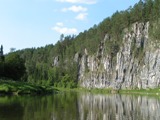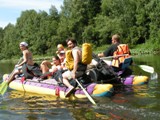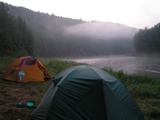You will enjoy the unique opportunity of visiting the Urals’ most famous river.
 This is the river of travelers, scientists, and pathfinders. The river flowing across the mountain ridge from Asia to Europe. The river whose banks represent the Ural Mountains cross-section and can be read as the original chronicle of the Earth from Neogene to Devonian and back. You will see huge cliffs go up sheer into the sky, each of them with its own name and story, picturesque grottos and caves, primeval man’s sites and half-ruined villages of the Soviet regime slaves. You will hear the legends of iron caravans passing to and fro at the times when the Chusovaya river was the only transportation line between the metallurgical Urals and the center. You will learn about stone warriors sinking barges and taking human lives. The river is cloaked in countless fairy-tales, superstitions, and mysteries. You will have the chance to touch the severe wild nature of the Urals.
This is the river of travelers, scientists, and pathfinders. The river flowing across the mountain ridge from Asia to Europe. The river whose banks represent the Ural Mountains cross-section and can be read as the original chronicle of the Earth from Neogene to Devonian and back. You will see huge cliffs go up sheer into the sky, each of them with its own name and story, picturesque grottos and caves, primeval man’s sites and half-ruined villages of the Soviet regime slaves. You will hear the legends of iron caravans passing to and fro at the times when the Chusovaya river was the only transportation line between the metallurgical Urals and the center. You will learn about stone warriors sinking barges and taking human lives. The river is cloaked in countless fairy-tales, superstitions, and mysteries. You will have the chance to touch the severe wild nature of the Urals.
The middle part of the Chusovaya where our route will lie is the most interesting section of the river. It is not until here that the Chusovaya obtains its true character – that of a river streaming its way through the rocky gorges. The river-bed is very winding, and the speed of the current is uneven. With almost every kilometer you will discover striking places such as a stormy rift, a still back-water, two or three canals between the islands, or a stretch of river… And everywhere, all the way there will be cliffs standing along the banks as though on guard. The exposures of limestone, dolomite, and slate of different colors create a sophisticated palette that took more than 500 million years to have formed. The cliffs on the Chusovaya are called “stones”, and the most dangerous of them – “warriors”.
 Many of the warriors are stained with the black holes of caves and grottos. Almost all the Chusovaya caves are of karst origin, and appeared as a result of rocks wash-out.
Many of the warriors are stained with the black holes of caves and grottos. Almost all the Chusovaya caves are of karst origin, and appeared as a result of rocks wash-out.
The Chusovaya flows through the forest zone of the Mountainous Ural. Its banks are covered with fur and silver fur taiga, with a touch of birch-trees, sometimes asps, lindens and pines. Occasionally you come across a small pine forest. The woods are rich in berries: bilberries, cowberries, stone berries, and wild raspberries. They also abound in animals and birds. The elk, roe, bear, fox, lynx, and others are found here. There is plenty of game-bird: wood-grouses, black grouses, hazel grouses; and floodplain lakes are home to waterfowl such as ducks and geese.
Archeologists are of the opinion that it is on the Chusovaya banks that the most ancient remains of the human presence in the Urals are discovered.
The first mention of the Chusovaya in the Russian chronicles dates back to 1396. At that time its banks were inhabited by the Mansi tribes. The first Russian settlement on the Chusovaya – Nizhnechusoviye Gorodki – appeared in 1568. It was from there that Ermak and his people’s Siberian campaign of September 1581 started.
The army went up as far as the Serebryanka river, reached its head water, and got across to the basin of the Tagil river. After Ermak had defeated Siberian Chan Kuchum, a lot of Russian settlements came into being along the Chusovaya. But it was not until the XVIII century that the Chusovaya banks saw the boom of activities at the time when big metallurgic plants were built in the Urals. The Chusovaya became the main waterway along which metal and other products were transported from the Urals to the European part of Russia.
 Our trip will start from the tract of Zhuravlik (Little Crane) that can be accessed by a country-track from the town of Lysva.
Our trip will start from the tract of Zhuravlik (Little Crane) that can be accessed by a country-track from the town of Lysva.
 The means of transport used will be catamarans as they are comfortable, and most rafters love it. You will have at your disposal all the necessary individual and group equipment, insurance against accidents, instructors, guides, and cook-house services.
The means of transport used will be catamarans as they are comfortable, and most rafters love it. You will have at your disposal all the necessary individual and group equipment, insurance against accidents, instructors, guides, and cook-house services.
That’s not enough to read and hear – you are welcome to experience it!






